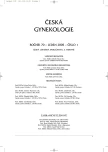-
Home page
- Journal archive
- Current issue
Risk Factors of the 3rd and 4th Degree Tear during Delivery
Rizikové faktory ruptury perinea 3. (a 4.) stupně během porodu
Cíl práce:
Shrnutí vzájemného vztahu vaginálního porodu a anální inkontinence.Typ studie:
Retrospektivní studie.Název a sídlo pracoviště:
Gynekologicko-porodnická klinika LF UK a FN, Plzeň.Metodika:
Hodnoceno je 9600 vaginálních porodů mezi roky 1997–2004. Sledována je incidence ruptury perinea 3. stupně a vztah vybraných porodnických faktorů. Hodnocení vlastní diagnostiky poranění.Výsledky:
Incidence těžké ruptury perinea byla 0,84 %. Incidence ruptury perinea 3. stupně, byla statisticky mnohem častější, pokud byla diagnostika provedena autory studie – urogynekology (p<0,001). Statisticky signifikantní faktory ruptury perinea v unifaktoriální i multifaktoriální analýze byly: forceps, dystokie ramének, délka 2. doby porodní a spolupráce rodičky na konci porodu. Parita (primiparita), porodní hmotnost a celkové hodnocení episiotomií byly statisticky signifikantní jako rizikový faktor v unifaktoriální analýze, ne však v multifaktoriální analýze. Provedení mediolaterální episiotomie signifikantně nezvýšilo ani nesnížilo prevalenci ruptur 3. stupně.Závěr:
Vlastní diagnostika stupně poranění hráze při porodu vyžaduje detailní znalosti struktury hráze a anatomie pánevního dna. Dostatek zkušeností a erudice jsou předpokladem prevence, diagnostiky a následného ošetření tohoto traumatu.Klíčová slova:
ruptura hráze 3. stupně, perineální trauma, porod, forceps, episiotomie, spolupráce rodičky
Authors: V. Kališ; P. Chaloupka; Jakub Turek
; Z. Rokyta
Authors‘ workplace: Gynekologicko-porodnická klinika LF UK a FN, Plzeň, přednosta doc. MUDr. Z. Rokyta, CSc.
Published in: Ceska Gynekol 2005; 70(1): 30-36
Category: Original Article
Overview
Objective:
Summary of the mutual relationship between vaginal delivery and anal incontinence.Design:
Retrospective case-control study.Setting:
Department of Gynaecology and Obstetrics, Charles University and Faculty Hospital Pilsen, Czech Republic.Methods:
9600 vaginal deliveries between January 1997 and March 2004 were evaluated. The aim of the study was to observe the incidence of the 3rd degree tear and identification of the risk factors. The recognition of the perineal injury was open to the individual interpretation and assessment of the doctors involved.Results:
The incidence of the 3rddegree tear was 0.84%. The diagnostics of the 3rd degree tear was significantly more frequent if the evaluation of the perineal injury was performed by the urogynaecologists (p<0.001). Statistically significant risk factors of the 3rd degree tear in the univariate and multivariate analysis were: forceps, shoulder dystocia, the length of the 2nd stage of labour and maternal cooperation at the final phase of delivery. Parturity (primiparity), birth weight and episiotomy (when all types of episiotomy were included) were statistically significant only in the univariate analysis. Mediolateral episiotomy was not proved to be either the risk or the protective significant factor.Summary:
The diagnostics of the 3rd degree tear demands a detailed knowledge of the structure and anatomy of the pelvic floor. Asufficient amount of experience and erudition are the requirements for the prevention, diagnostics and subsequent treatment of this injury.Key words:
third degree tear, perineal trauma, delivery, forceps, episiotomy, maternal cooperation
Labels
Paediatric gynaecology Gynaecology and obstetrics Reproduction medicine
Article was published inCzech Gynaecology

2005 Issue 1-
All articles in this issue
- New Options in Pharmacological Treatment of Urge Urinary Incontinence in Women
- Importance of Registry of Aggregated Data on Women Giving Birth
- Analysis of Maternal Mortality in the Czech Republic in 2001
- Analysis of Present Diagnostic Methods of Intrapartal Fetal Hypoxia
- Contribution of Doppler Examination in Pregnancy at Risk of Alloimune Fetus Anemia
- Risk Factors of the 3rd and 4th Degree Tear during Delivery
- Birth Defects in the Czech Republic – Expected Incidence in the Coming Years
- Pelvic Exenteration
- Possibilities of Increased Radicality in Pelvic Exenteration
- Abdominal hysterectomy – Risk Factor in Development of Urinary Incontinence? Results of a Questionnaire Study
- MMP-26 mRNA and Estrogen Receptor Alpha Co-expression in Normal and Pathological Endometrium
- Protein bcl-2 Expression in the Mid-secretory Endometrium after Oral Estrogen-Progesterone Preparation
- Syndrome of Pseudomyxoma Peritonei – Description of Three Cases and Survey of the Problem
- Cystic Hypersecretory Carcinoma: Rare and Potentially Aggressive Variant of Intraductal Carcinoma of the Breast. Report of Five Cases
- Czech Gynaecology
- Journal archive
- Current issue
- About the journal
Most read in this issue- Abdominal hysterectomy – Risk Factor in Development of Urinary Incontinence? Results of a Questionnaire Study
- Risk Factors of the 3rd and 4th Degree Tear during Delivery
- Syndrome of Pseudomyxoma Peritonei – Description of Three Cases and Survey of the Problem
- Contribution of Doppler Examination in Pregnancy at Risk of Alloimune Fetus Anemia
Login#ADS_BOTTOM_SCRIPTS#Forgotten passwordEnter the email address that you registered with. We will send you instructions on how to set a new password.
- Journal archive
